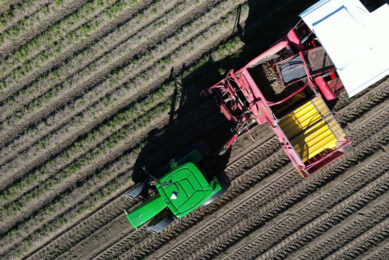Remember spray basics amidst fancy tech

GPS, variable rate tech, new equipment designs and other innovations continue to make spraying more precise and efficient.
The potency and volatility of common grain crop herbicides like dicamba, however, means it pays to think about sprayer basics as well as the latest precision technology.
When it comes to dicamba, that means properly flushing and washing sprayers, and being extra-aware of appropriate climactic conditions for application.
Ammonia and thorough rinsing
The sensitivity of soybeans and other plants to dicamba, a volatile auxin-based herbicide, is extreme. Even trace amounts can cause significant damage to susceptible crops, and residue left in sprayer lines, tanks, and nozzle heads can devastate on non-tolerant crops.
Ammonia is often used and required on pesticide labels to help neutralise dicamba in sprayer flushes. Sprayer rinsing tests performed by experts at the Ontario Ministry of Agriculture, however, show ammonia can make the danger posed by dicamba rinsate (contaminated wash water) more acute for a short period.
For this reason, field crop specialist Andrew Geerligs and Richard Anderson of BASF Canada say a triple rinse system employing ammonia during the second rinse is standard procedure for eliminating residues in sprayer lines and tanks – and for good reason.
“Farmers who forget the ammonia, we see it on their crops,” says Geerligs. “As little as 3 millilitres can contaminate a 1,000-gallon tank.” They add cleaning regimes should also include the pumps used to transfer product, as well as the outside of the sprayer itself.
“We always forget about the outside,” Anderson says. “Where there’s an issue, it’s because something’s been overlooked.”
Jason Deveau, application technology specialist and “spray guy” with Ontario’s agriculture ministry, says farmers who have used dicamba or similar chemicals can take a number of extra steps to ensure they eliminate or at least mitigate the risk such residues pose to them and their neighbours’ crops.
First, ensure there are no acidic solutions present in the tank before using dicamba in the first place. Doing so turns a comparatively benign dicamba solution into a much more volatile “1960’s style chemical” – which isn’t good for anyone.
Second, ensure all dead-end lines, filters, and nozzles are thoroughly washed. As represented in Deveau and his colleague’s work, dicamba residue in the remaining parts of the sprayer (as in not just the tank and hoses) can be just as deadly to non-target plants.
Take steps to eliminate drift
Throwing caution to the wind during application can also carry dicamba damage with it. Partical drift caused by wind and vapour drift caused by temperature inversions – where cool, particle-laden air cannot rise and flows either downhill or with light breezes – has been a notable issue in parts of Ontario, and a particularly acute problem in hotter grain-growing areas of the United States. As described by Deveau, the scale for the former is in metres while the scale of the latter can be measured in kilometres.
To avoid these problems, Deveau and other agriculture ministry experts say dicamba should be applied at lower pressures, with larger droplets, and at lower speeds to allow for lower boom heights.
Knowing when temperature inversions are most acute and most likely – generally around sunrise – and not planting in extreme heat – where dicamba can evaporate – is also critical to spraying at appropriate times. These are just general best management practices, of course, as regulations and application requirements can differ between countries.
Regardless, If you’ve already invested in precision sprayer tech, remembering sprayer basics is an easy way to help ensure things work as anticipated. After all, wouldn’t we all prefer our herbicides stay where the GPS systems put them?
Join 17,000+ subscribers
Subscribe to our newsletter to stay updated about all the need-to-know content in the agricultural sector, two times a week.



